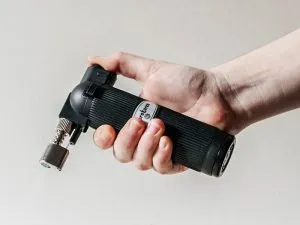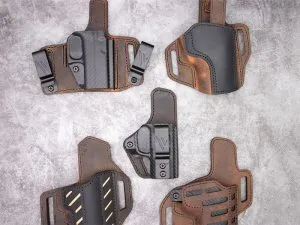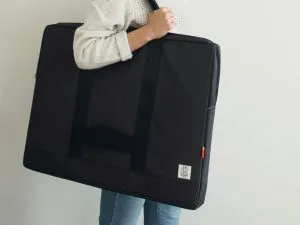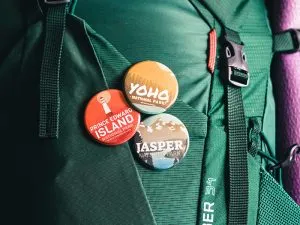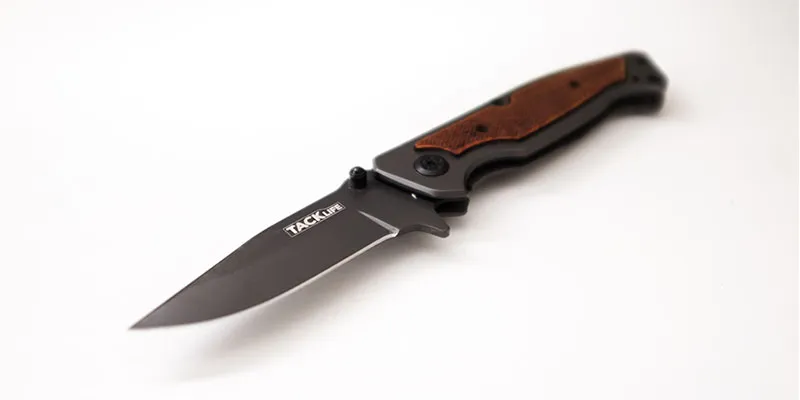
Carry-on bags
No
Checked luggage
Yes, with conditions
Rules for Flights in the USA
On flights within the United States, all types of knives are allowed in checked luggage without restrictions. In hand luggage all knives are banned, except for plastic knives and round-bladed butter knives.
When packed in checked luggage, knives should be securely wrapped, put into a box, or in a knife holster – the sharp edge shouldn’t be exposed. They ask this because security officers often do additional inspections in checked bags, and they must be protected from accidental injuries. In fact, if you’d put a bare knife into your checked bag and the security officer would accidentally get injured, you could get sued. So always remember to properly protect your knives in checked baggage.
The TSA officers aren’t responsible for determining whether a knife is legal or illegal, but if they suspect that your knife classifies as illegal (a too-long blade, concealed blade, etc.), they might get in touch with the local authorities. So make sure to know the local state knife laws before your trip.
Lastly, there aren’t any limits to how many knives each passenger can bring.
Rules for Flights in Other Countries
Canada
On Canadian flights, knives with a blade length of 6 cm (2.36 inches) or shorter are allowed both in hand and checked luggage. Usually, small scissors, nail clippers, multi-tools, and pocket knives fall within this category. Knives with blades over 6 cm are also allowed, but only in checked baggage.
Furthermore, switchblades, push-button knives, concealed knives, and knives resembling different objects are completely banned from Canadian flights, as they’re considered illegal under federal law.
The United Kingdom
The UK flight authorities allow only knives with blunt ends and with a blade length of 6 cm (2.36 inches) or less in hand luggage. If the knife has a sharp end or the blade is over 6 cm, then it can travel only in checked luggage. In reality, only small scissors with round ends are allowed in hand luggage. In checked baggage, all knives are allowed.
Europe, Australia, China, and India
European, Australian, Chinese, and Indian rules are similar to the US – all knives are banned from hand luggage, regardless of the blade length and whether the end is pointy or blunt. Knives are only allowed in checked baggage.
New Zealand
On New Zealand flights, only knives with blades shorter than 6 cm (2.36 inches) are allowed in hand luggage. Longer knives can only be packed in checked luggage. Pocket knives and multi-tools aren’t opened – instead, they measure the tool itself to estimate roughly how long the knife may be. If a pocket knife or multi-tool measures over 9.5 cm (3.74 inches) in length, it won’t be allowed in hand luggage.
Sources: For writing this article, we took information only from official sources, like airline regulators, government websites, and major airlines. If you want to confirm that our information is accurate and up to date, click on any of the links mentioned above. We linked out to where we found this information for each country.
Disclaimer: The final decision of whether you can bring knives on planes always rests on the security officer. Some airlines also have additional rules that may be different. Also, this is not legal advice. We only find relevant information online, which we base this article on, but some of it may become outdated or incorrect. That’s why you should always do your own research.
The Types of Knives That Are Allowed in Checked Luggage
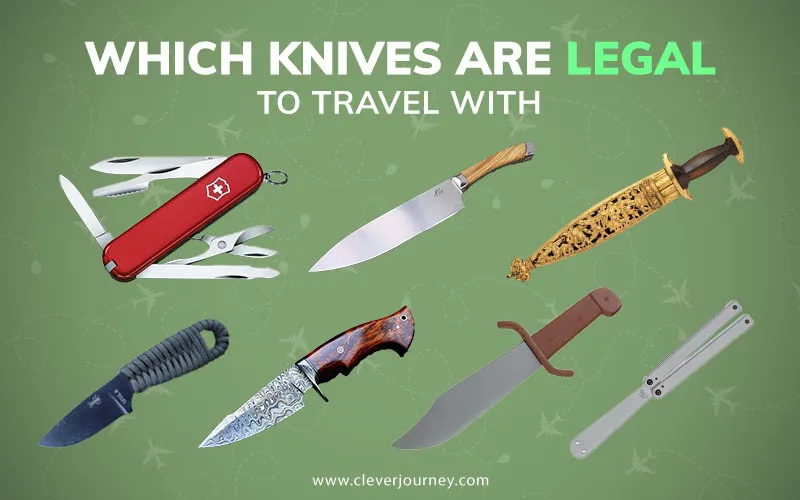
Knife rules can get messy, because each state, region, and country has different rules on which types of knives are legal and which aren’t. And obviously, you can’t pack illegal knives in your checked luggage because you could get into legal trouble. That’s why down below, we covered which types of knives are usually legal to carry and own across the world, although some of them might be banned in certain regions.
- Pocket knives. These include Swiss Army Knives, multi-tools, and other small knives, where the knife folds into a protective shell. These don’t include knives that open quickly with a button, spring, or any other mechanism, which are banned in most countries.
- Kitchen knives. Most kitchen knife sets, including large meat cleavers and long meat knives, are allowed in checked baggage.
- Blunt, antique, decorative knives. Most antique knives, even with blade length above the limit, are considered legal if they’re blunt and meant for decorative purposes. That said, curved knives, even blunt ones, are considered illegal in some regions.
- Fixed-blade knives with a short blade. The rules are different for each country and state, but usually, fixed-blade knives with a blade below 4-6 inches (10-15 cm) are legal and can be packed in checked luggage when traveling.
- Damascus knives. Most Damascus kitchen knives or short fixed-blade knives are also legal to pack in checked luggage.
- Plastic toy knives and swords. Toy knives and swords are banned from hand luggage, but they’re allowed in checked baggage.
- Balisong trainer squiddy knives. Real butterfly knives are usually considered illegal, but ones without sharp blades are fine to bring even in hand luggage.
The Types of Knives That Are Illegal to Travel With
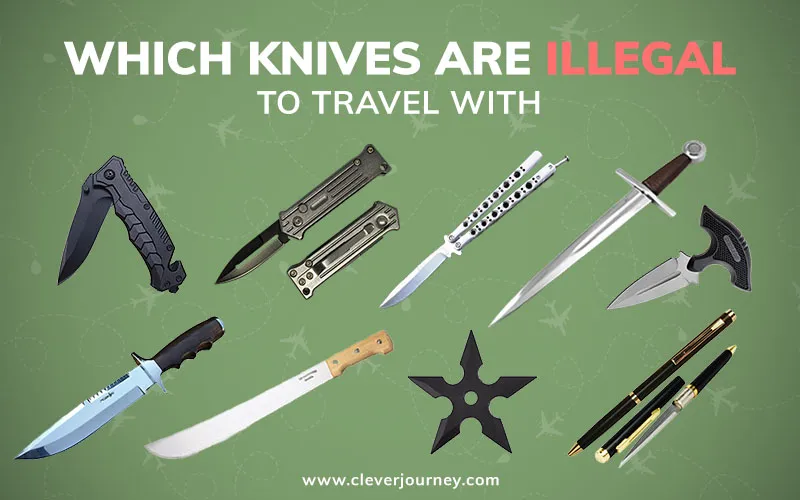
Some knives are considered illegal, based on their design, blade length, and other factors. If you’d travel with one of these knives in your checked luggage, the airport security agent would most likely get in touch with the local authorities and you would get into trouble. The rules can be incredibly complicated and are different for each country and state, but down below, we’ve compiled which knives are considered illegal by most authorities.
- Switchblades, flick knives, and spring-loaded knives. Although some states and countries will allow small switchblades, most commonly they’re banned. This includes all knives that have some kind of mechanism that quickly releases the blade, or the blade can be opened with one hand using the weight of the blade.
- Daggers and push daggers. Historical daggers and push daggers are banned in most countries and states.
- Swords, machetes, and spears. Sharp swords, machetes, and even spears are also considered dangerous weapons and are banned in most countries and states.
- Throwing stars, death stars, and throwing knives. Although throwing stars and knives are mainly meant for hobby purposes, they can also be used as weapons, which is why they’re banned in most places around the world.
- Knives resembling different objects. Most everyday objects that have a hidden knife inside them (for example, pens, combs, etc.) are considered illegal.
- Butterfly knives. Although butterfly knives are mostly used for training as a hobby, they’re considered illegal almost everywhere in the world. Only butterfly knives without sharp blades are allowed in checked baggage.
- Fixed-blade knives with long blades. This depends on the state and country, but most fixed-blade knives over 4-6 inches (10-15 cm) are considered illegal. There are certain exceptions for people with fishing and hunting licenses in some states and countries.
How to Pack Knives in Checked Baggage
Airport security requires all passengers to safely secure knives packed in checked baggage. The sharp edge must be covered to avoid accidental injuries when performing inspections on the bag. If you wouldn’t safely secure a knife and the security agent would get injured, you could theoretically get sued.
There are many ways you can safely pack knives in checked luggage, including:
- Secure the blade between two cardboard pieces. If you don’t have any safe place to put your knife in, putting it inside a sock won’t cut it – the end will still poke through, and may even damage your suitcase. The best thing that you can do in this situation is to make a holster out of cardboard. Simply cut a cardboard piece that’s 1 inch longer than the blade, wrap it around the sharp end of the blade, and secure it all with some duct tape. This should be enough to keep the sharp part of the blade from being exposed.
- Use paper and tape to secure the sharp edge. First, tightly wrap some paper or napkins around the blade, to create a layer between the knife and the sticky part of the tape, which will ensure that the blade stays clean of any glue residue. Then wrap it all in duct or masking tape, which should hold everything in place.
- Use a knife holster. A leather or fabric knife holster will also be enough to pack your knife safely in your luggage.
- Pack it inside a box. The most secure option would be to pack your knives in a dedicated box or a fabric roll bag.
Frequently Asked Questions About Bringing Knives on Planes
Can I bring a knife in checked luggage when traveling internationally?
First of all, the knife has to be packed securely in your checked bag, with the sharp edge protected. This is a requirement by the airline security to avoid accidental injuries when performing inspections of the bag.
And secondly, you should avoid packing knives that are illegal in the countries/states you’re flying through. This includes flick knives, push-button knives, butterfly knives, knives resembling different objects, and knives with long blades. Knives that are legal in most countries include pocket knives, multitools, short fixed-blade knives, and kitchen knives.
Do you have to declare knives in checked luggage?
If you’re flying back from overseas and you’re bringing a knife that you purchased abroad, then you should declare it anyway, because you have to declare everything that you bought abroad. You might also have to pay an import tax on it, depending on its value and where you’re flying from.
What size knife is legal to carry on planes?
In hand luggage, usually, no knives are allowed, except for a few countries that have restrictions for the blade length. For example, in the US, all knives are banned in hand luggage, regardless of the blade length. But in Canada and New Zealand, knives with a blade length below 6 cm (2.36 inches) are allowed onboard. The UK also enforces the 6 cm (2.36 inches) blade length limit, but they prohibit all sharp items in hand luggage, which disqualifies most knives.
What are the TSA knife rules for 2023?
In checked baggage, TSA allows pretty much any knife. TSA isn’t responsible for determining which knives are legal or not, so sometimes, they’ll let even illegal knives be packed in checked bags. However, if the security agent thinks that a certain knife might be illegal in that state, he will most likely get in touch with the local authorities.
What are some TSA-approved knives?
In theory, TSA allows round-bladed butter knives and plastic knives. But sometimes, even butter knives are removed from passengers’ hand luggage because the final decision always rests with each individual security officer. If you’re dead certain that you need a knife in hand luggage, then you should pack only inexpensive plastic knives, which can be disposed of in case the security agents require you to do that, like the HumanGear plastic utensil set.
Are pocket knives allowed on planes?
In Canada and New Zealand, small pocket knives are allowed on flights in hand luggage. In Canada, the blade length of the pocket knife must be below 6 cm (2.36 inches). In New Zealand, the pocket knife itself must be below 9.5 cm (3.74 inches) in length in order to be allowed on planes. The Victorinox Swiss Army MiniChamp Pocket Knife would be okay to use on Canadian and New Zealand flights since it’s 1.96 inches (5.8 cm) in size and has a blade length of 1.25 inches (3.2 cm).
Can I bring cutlery (silverware) on planes?
In checked luggage, there aren’t any restrictions for bringing cutlery – even sharp knives are allowed. However, packing expensive cutlery in checked baggage isn’t really safe because sometimes, checked bags get lost, or stuff gets stolen from them during baggage handling. So we would advise packing expensive cutlery sets with round-bladed butter knives in hand baggage.
Read Next: Can You Bring Can Openers on Planes?
How do I prevent my knife from getting stolen in checked luggage?
To reduce the chances, you could avoid packing it in expensive-looking boxes and holsters. Some people have reported packing their knives in a plastic bag, which then is smeared with something dirty and put into another bag, which would make the job much messier for any potential thief.
In conclusion
The rules for carrying knives on flights vary from country to country. In the United States, knives are allowed in checked luggage with some precautions, while they are strictly prohibited in hand luggage except for plastic and round-bladed butter knives. Passengers should ensure proper packaging to avoid accidents.
Local state laws should be considered, as the TSA may involve local authorities if a knife is suspected to be illegal. Other countries like Canada, the United Kingdom, Europe, Australia, China, India, and New Zealand have their own specific regulations regarding knives on flights, with restrictions based on blade length and design.
Travel safely and always check and adhere to the specific rules of the country you are flying to or from.

 (5 votes, average: 4.80 out of 5)
(5 votes, average: 4.80 out of 5)